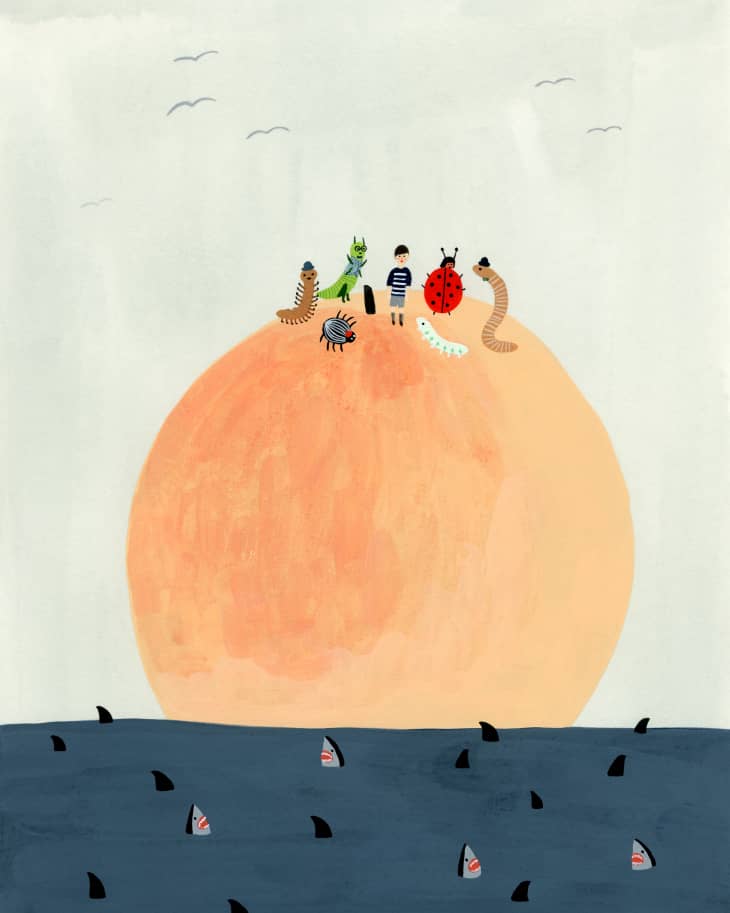Why James and the Giant Peach Could Never Be About Cherries
Fruit will always be ripe for children’s literature — “A is for apple” graces the first page of almost any self-respecting alphabet book, after all — but a peach is a particularly rich fruit for this job, conveying a sense of sweetness around its dark stone center, or its regional and cultural connections. It’s just unusual enough to be slightly left of the more typical fruits.
Take, for example, Roald Dahl’s fantastical novel James and the Giant Peach. With Roald Dahl’s talent for storytelling, there’s no question that James and the Giant Cherry (actually a real consideration according to Dahl’s private diaries) would have been successful, but there’s something about James and the Giant Peach that evokes the story itself — the kind that will leave juice running down your chin, the kind with a hard center that will surprise you if you’re not careful.
This is Dahl’s trademark, after all — mixing the sweet with the sour and the downright dark. What else besides a peach, with its complexities and contradictions — a fuzzy exterior, juicy interior, and hard stone in the middle — would suffice as the vehicle for magical and twisted adventures with a cast of fantastically large insects?
Peaches are complicated, rich, and downright magical in James and the Giant Peach, but the story only shows one aspect of this mighty fruit. Throughout literature — although especially in children’s books and young adult novels — peaches can uniquely express emotions that other fruits (and really food, for that matter) simply can’t touch.
This is Dahl’s trademark, after all — mixing the sweet with the sour and the downright dark.
Peaches are a visually interesting fruit; their skin is a sunset of colors. They inspire rich illustrations in books like Peach & Blue, written by Sarah S. Kilborne with paintings by Steve Johnson and Lou Fancher. In Peach & Blue, the titular peach is saddened by the idea that she’s reached her prime ripeness, and now there’s nothing left for her but to be turned into a cobbler or tart. Blue, a blue-bellied toad, helps her down from the branch and together they embark on an adventure and the start of a tender friendship. It would be hard to imagine any fruit working as well as a peach, with its soft swirls of orange and red contrasting with the blues and greens of the landscape and its toad friend.
As the official fruit of the State of Georgia, there’s also a Southern association to many depictions of peaches, which makes them a go-to fruit for children’s books set in that region. In YA novels like Peaches by Jodi Lynn Anderson or Georgia Peaches and Other Forbidden Fruit by Jaye Robin Brown, setting a female coming-of-age story in rural Georgia sets up many of the conflicts between what a girl is “supposed” to be versus who she actually is. Traditionally, peaches have been associated with femininity, with being sweet and demure. But in both Anderson and Brown’s novels, they harken back to that same sensuality that made Dahl choose the fruit for James. It is almost impossible to eat a peach neatly, to avoid the stickiness of the juice or the texture of the flesh. In that way, they are a perfect choice for stories about desire and discovery. The fact that they are associated with a more traditional Southern culture only highlights the tension in those stories.
Peaches have added significance in many Asian cultures, as well. In Japan, peaches are often associated with immortality and longevity, as seen in the popular Japanese folktale has Momotarō, often translated as “Clam Peach Boy.” In the story, a boy floats down the river in a giant peach, where he is then rescued by a childless couple when they try to eat the peach and discover a boy inside. It’s significant that Momotarō emerges from that fruit in particular in order to bring prosperity to his parents. When Momotarō grows up, he leaves home to fight a band of monsters with the help of some animal friends, and returns to his family for a prosperous life.
Similarly, in Chinese culture, the peach is a symbol of vitality, and peach blossoms are prized partly because they can appear before the leaves on a peach tree even sprout. The peach is one of the three blessed fruits in Buddhism, together with the pomegranate and citrus.
In Korea, peaches are considered to be one of 10 immortal plants and animals, and are deemed lucky for their connection to happiness and prosperity. Yansook Choi’s picture book Peach Heaven uses that symbolism to tell the story of a girl who dreams of a plentiful peach orchard. When the sky begins to rain peaches, the girl is ecstatic, delighting in the never-ending supply of the delicious fruit. She soon realizes that she can’t enjoy her bounty, however, when she thinks of all the farmers who have lost their harvest from the rain, and decides to help them.
It is almost impossible to eat a peach neatly, to avoid the stickiness of the juice or the texture of the flesh. In that way, they are a perfect choice for stories about desire and discovery.
Alice Walker once said, “Life is better than death, I believe, if only because it is less boring and because it has fresh peaches in it.” When it comes to peaches in children’s literature, one thing is for sure — they’re anything but boring.
